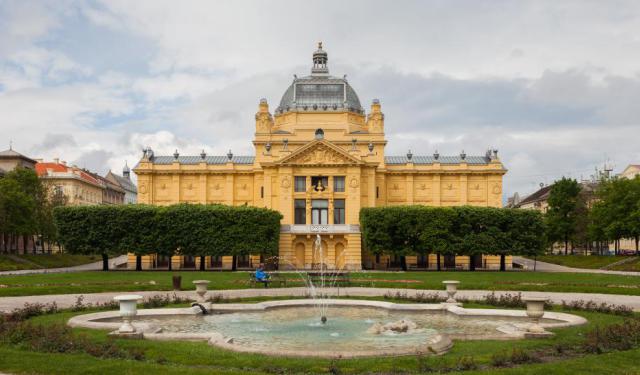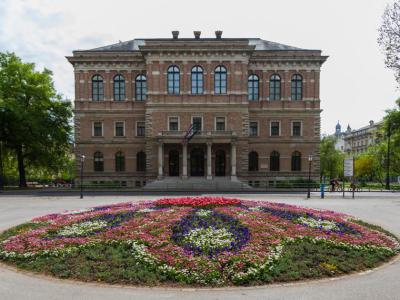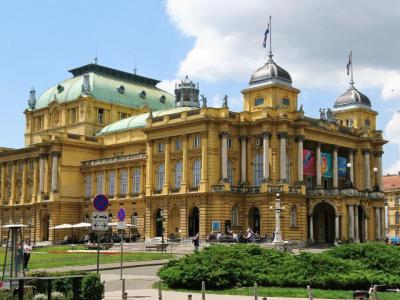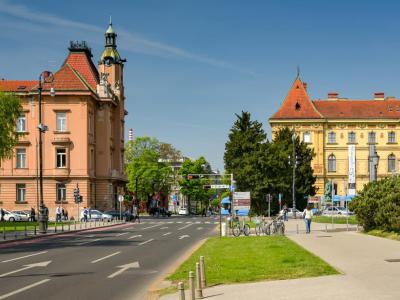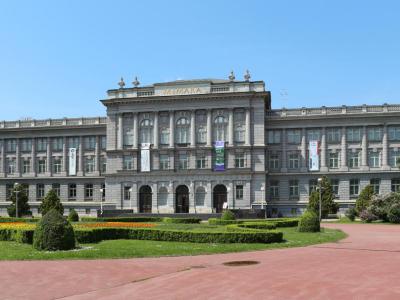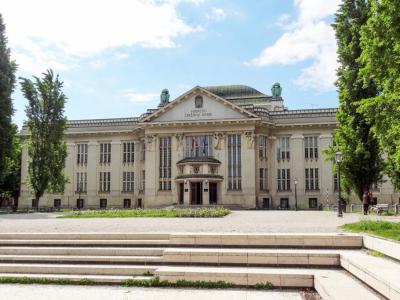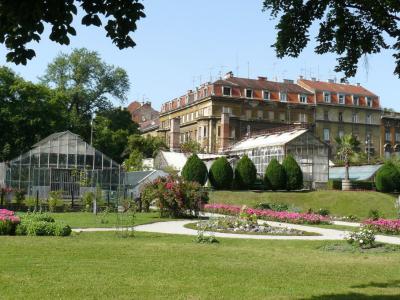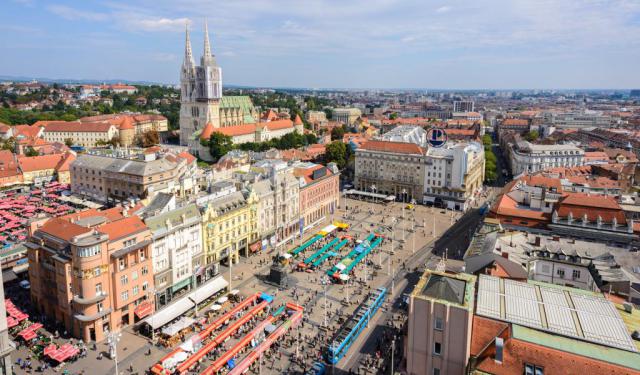Lower Town Walking Tour (Self Guided), Zagreb
The Lower Town of Zagreb, also known as Donji Grad, is one of the two main districts in the historic heart of the Croatian capital, alongside the Upper Town (Gornji Grad). It is the more modern of the two and was built during the period of urban expansion, in the late 19th and early 20th centuries.
The Lower Town showcases a captivating tapestry of architectural splendor dominated by Austro-Hungarian and Art Nouveau designs, in which historic facades stand as timeless guardians of the city's grandeur. The sweeping boulevards lined by elegant buildings, stately squares, and green parks all contribute to the area's aesthetic charm and exude an air of refined sophistication.
A gateway to the city center is King Tomislav Square, a large square dedicated to the first Croatian king, now serving as a popular meeting place. Overlooking the square is the Art Pavilion, a magnificent venue, one of the oldest exhibition spaces in Southeast Europe.
Another major cultural attraction, not far away, is Strossmayer's Old Masters Gallery – home to an extensive collection of European art. Just across the road from it lies the vibrant Nikola Šubić Zrinski Square, named after a Croatian nobleman and military leader.
The list of cultural attractions of note goes on to include the Croatian National Theater found near Republic of Croatia Square, a bustling space lined with shops, cafes, and historical buildings, nowadays often used for various outdoor events and concerts. The Mimara Museum is also worth visiting for its impressive display of art and historical artifacts from different epochs and civilizations.
The Lower Town of Zagreb stands as a testament to the city's enduring commitment to elegance and timeless charm. Meandering through its streets is like entering a realm of cultural opulence, where every corner whispers stories of a bygone era. If you wish to do it in your good time, take this self-guided walk and enjoy yourself.
The Lower Town showcases a captivating tapestry of architectural splendor dominated by Austro-Hungarian and Art Nouveau designs, in which historic facades stand as timeless guardians of the city's grandeur. The sweeping boulevards lined by elegant buildings, stately squares, and green parks all contribute to the area's aesthetic charm and exude an air of refined sophistication.
A gateway to the city center is King Tomislav Square, a large square dedicated to the first Croatian king, now serving as a popular meeting place. Overlooking the square is the Art Pavilion, a magnificent venue, one of the oldest exhibition spaces in Southeast Europe.
Another major cultural attraction, not far away, is Strossmayer's Old Masters Gallery – home to an extensive collection of European art. Just across the road from it lies the vibrant Nikola Šubić Zrinski Square, named after a Croatian nobleman and military leader.
The list of cultural attractions of note goes on to include the Croatian National Theater found near Republic of Croatia Square, a bustling space lined with shops, cafes, and historical buildings, nowadays often used for various outdoor events and concerts. The Mimara Museum is also worth visiting for its impressive display of art and historical artifacts from different epochs and civilizations.
The Lower Town of Zagreb stands as a testament to the city's enduring commitment to elegance and timeless charm. Meandering through its streets is like entering a realm of cultural opulence, where every corner whispers stories of a bygone era. If you wish to do it in your good time, take this self-guided walk and enjoy yourself.
How it works: Download the app "GPSmyCity: Walks in 1K+ Cities" from Apple App Store or Google Play Store to your mobile phone or tablet. The app turns your mobile device into a personal tour guide and its built-in GPS navigation functions guide you from one tour stop to next. The app works offline, so no data plan is needed when traveling abroad.
Lower Town Walking Tour Map
Guide Name: Lower Town Walking Tour
Guide Location: Croatia » Zagreb (See other walking tours in Zagreb)
Guide Type: Self-guided Walking Tour (Sightseeing)
# of Attractions: 9
Tour Duration: 2 Hour(s)
Travel Distance: 2.5 Km or 1.6 Miles
Author: jenny
Sight(s) Featured in This Guide:
Guide Location: Croatia » Zagreb (See other walking tours in Zagreb)
Guide Type: Self-guided Walking Tour (Sightseeing)
# of Attractions: 9
Tour Duration: 2 Hour(s)
Travel Distance: 2.5 Km or 1.6 Miles
Author: jenny
Sight(s) Featured in This Guide:
- King Tomislav Square
- Art Pavilion
- Strossmayer's Old Masters Gallery
- Nikola Šubić Zrinski Square
- Croatian National Theater
- Republic of Croatia Square
- Mimara Museum
- Croatian State Archives
- Botanical Garden
1) King Tomislav Square
King Tomislav Square is a meticulously maintained public area, surrounded by lush trees and vibrant flowerbeds, and is highlighted by the striking yellow exterior of the Art Pavilion. It's adjacent to an underground shopping center and faces the bustling central train station, making it a popular spot for locals and visitors alike.
Originally named after Franz Joseph I, the square was renamed to honor King Tomislav post the Austro-Hungarian Empire's dissolution. Tomislav is celebrated for unifying the Croatian regions of Dalmatia and Pannonia, forming the Kingdom of Croatia. A prominent monument, unveiled in 1947, stands in the square, showcasing King Tomislav on horseback atop a substantial base.
The north end of the square features the Art Pavilion, an architectural marvel that fuses classical design with elements of Art Nouveau. On sunny summer days, the square is a favorite spot for locals to bask in the sun and relax on the grass. You can rest on a bench near the central fountain or walk along the perimeter paths, admiring the meticulously kept flower beds.
In winter, the square transforms with an ice rink and trees adorned with fairy lights, creating a festive atmosphere. The square remains open to the public at all times. For a different experience, visit at night when the Art Pavilion is lit up, bathing the northern end of the square in a warm, golden light.
Originally named after Franz Joseph I, the square was renamed to honor King Tomislav post the Austro-Hungarian Empire's dissolution. Tomislav is celebrated for unifying the Croatian regions of Dalmatia and Pannonia, forming the Kingdom of Croatia. A prominent monument, unveiled in 1947, stands in the square, showcasing King Tomislav on horseback atop a substantial base.
The north end of the square features the Art Pavilion, an architectural marvel that fuses classical design with elements of Art Nouveau. On sunny summer days, the square is a favorite spot for locals to bask in the sun and relax on the grass. You can rest on a bench near the central fountain or walk along the perimeter paths, admiring the meticulously kept flower beds.
In winter, the square transforms with an ice rink and trees adorned with fairy lights, creating a festive atmosphere. The square remains open to the public at all times. For a different experience, visit at night when the Art Pavilion is lit up, bathing the northern end of the square in a warm, golden light.
2) Art Pavilion
The Art Pavilion in Zagreb, established in 1898, holds the distinction of being the oldest gallery in Southeast Europe. Furthermore, it stands as the sole gallery in Zagreb that was purpose-built to house large-scale exhibitions. The initial proposal for this gallery's creation was made by Croatian painter Vlaho Bukovac in the spring of 1895.
The gallery boasts a spacious display area covering 600 square meters, yet it does not maintain a permanent collection. Instead, it specializes in hosting unique solo and group exhibitions that showcase significant artistic works and movements from various time periods and styles. These exhibitions feature the creations of both Croatian and international artists.
Over the course of its history, the gallery has organized approximately 700 exhibitions, featuring artists ranging from the Earth Group collective to prominent figures like George Grosz, Henry Moore, Auguste Rodin, Andy Warhol, Mimmo Rotella, and numerous others. Since 2005, an annual tradition has seen the publication of a CD-ROM, typically released around the anniversary of the Pavilion's founding. This CD-ROM offers a virtual tour of the exhibitions held in the preceding year.
Why You Should Visit:
It is a magnificent historical building with beautiful interiors and surrounded by lovely gardens, plus it always has some interesting exhibitions inside. Well worth the ticket price.
The gallery boasts a spacious display area covering 600 square meters, yet it does not maintain a permanent collection. Instead, it specializes in hosting unique solo and group exhibitions that showcase significant artistic works and movements from various time periods and styles. These exhibitions feature the creations of both Croatian and international artists.
Over the course of its history, the gallery has organized approximately 700 exhibitions, featuring artists ranging from the Earth Group collective to prominent figures like George Grosz, Henry Moore, Auguste Rodin, Andy Warhol, Mimmo Rotella, and numerous others. Since 2005, an annual tradition has seen the publication of a CD-ROM, typically released around the anniversary of the Pavilion's founding. This CD-ROM offers a virtual tour of the exhibitions held in the preceding year.
Why You Should Visit:
It is a magnificent historical building with beautiful interiors and surrounded by lovely gardens, plus it always has some interesting exhibitions inside. Well worth the ticket price.
3) Strossmayer's Old Masters Gallery
The Strossmayer Gallery of Old Masters is a fine art museum exhibiting the collection donated to the city by Bishop Josip Juraj Strossmayer in 1884. The Gallery exhibits the works of European painters from 14th-19th century.
The Strossmayer Gallery holding includes around 4,000 works, of which some 250 are on display, with the remainder in storage, or on display at other museums or gallery institutions in Croatia. The holdings have been classified into three major groups: Italian, French and Northern European (German, Flemish, and Dutch) works, and also some works by Croatian artists.
The Gallery is on the second floor of the Croatian Academy of Sciences and Arts that dates back to 1867. The building features Italian Renaissance style, and has been brought up to date technologically. The first director of the Academy was historian Franjo Racki.
The Strossmayer Gallery holding includes around 4,000 works, of which some 250 are on display, with the remainder in storage, or on display at other museums or gallery institutions in Croatia. The holdings have been classified into three major groups: Italian, French and Northern European (German, Flemish, and Dutch) works, and also some works by Croatian artists.
The Gallery is on the second floor of the Croatian Academy of Sciences and Arts that dates back to 1867. The building features Italian Renaissance style, and has been brought up to date technologically. The first director of the Academy was historian Franjo Racki.
4) Nikola Šubić Zrinski Square
Nikola Šubić Zrinski Square, commonly referred to as Zrinjevac, is a central and prominent area in Zagreb. Covering an area of about 12,540 square meters, it is surrounded by important buildings such as Croatia's Supreme Court, the Ministry of Foreign Affairs and European Integration, and the Zagreb Archaeological Museum. This square bears the name of Nikola Šubić Zrinski, who was a Croatian-Hungarian nobleman and military leader. He served as the Ban of Croatia from 1542 to 1556 and was a member of the prominent Croatian noble families Zrinski and Kurjaković. During his lifetime, the Zrinski family rose to become the most influential noble family in the Kingdom of Croatia.
Situated close to the central Ban Jelačić Square and on the way to the Main Railway Station, Nikola Šubić Zrinski Square is a key part of Zagreb's Green Horseshoe. This is a network of seven squares in the Lower Town area. The southern section of the square features busts of important Croatian figures, including Julije Klović, Andrija Medulić, Fran Krsto Frankopan, Nikola Jurišić, Ivan Kukuljević Sakcinski, and Ivan Mažuranić.
A notable feature of the square is its music pavilion, established in 1891 as a gift from Eduard Prister, a wealthy trader. The square, with its well-maintained gardens, old trees, and beautiful fountains, serves as a favorite leisure spot for locals. Visitors often enjoy leisurely walks along its tree-lined paths or relax on benches, taking in the serene environment, fountain views, and the scent of fresh flowers.
Situated close to the central Ban Jelačić Square and on the way to the Main Railway Station, Nikola Šubić Zrinski Square is a key part of Zagreb's Green Horseshoe. This is a network of seven squares in the Lower Town area. The southern section of the square features busts of important Croatian figures, including Julije Klović, Andrija Medulić, Fran Krsto Frankopan, Nikola Jurišić, Ivan Kukuljević Sakcinski, and Ivan Mažuranić.
A notable feature of the square is its music pavilion, established in 1891 as a gift from Eduard Prister, a wealthy trader. The square, with its well-maintained gardens, old trees, and beautiful fountains, serves as a favorite leisure spot for locals. Visitors often enjoy leisurely walks along its tree-lined paths or relax on benches, taking in the serene environment, fountain views, and the scent of fresh flowers.
5) Croatian National Theater
The Croatian National Theatre is a cultural institution in Zagreb that encompasses theater, opera, and ballet performances. Its origins can be traced back to 1834 when the first city theater was established in what is now the Old City Hall. However, it officially became the Croatian National Theatre in 1860 and received government support in 1861, elevating it to the status of other prominent European national theaters. In 1870, an opera company was integrated into the theater, and in 1895, it relocated to its present location on Republic of Croatia Square in Zagreb's Lower Town.
Emperor Franz Joseph I of the Austro-Hungarian Empire attended the inauguration of this new building during his visit to the city in 1895. This architectural masterpiece was designed by renowned Viennese architects Ferdinand Fellner and Herman Helmer, who had previously created several theaters in Vienna. The theater's entrance is adorned with a wall fountain called "The Source of Life" (Zdenac života), which was designed by Croatian artist and sculptor Ivan Meštrović in 1905.
Throughout its history, the theater has been home to numerous prominent Croatian artists. Its initial manager and dramatist was the Greek-Croatian poet Dimitrija Demeter, a key figure in the Croatian national revival movement, with Ivan Zajc serving as the first conductor. Notable figures like Branko Gavella, the renowned Croatian theater director, and Mia Čorak Slavenska, the first Croatian prima ballerina, began their careers at this institution.
Over the years, the theater has welcomed numerous international artists, including Franz Liszt, Sarah Bernhardt, Franz Lehár, Richard Strauss, Gérard Philipe, Vivien Leigh, Laurence Olivier, Jean-Louis Barrault, Peter Brook, Mario Del Monaco, and José Carreras.
Why You Should Visit:
It is a gorgeous building in a park-like setting, surrounded by other beautiful buildings. If you are lucky, you may catch a performance and get a chance to see its equally gorgeous interiors, too.
Emperor Franz Joseph I of the Austro-Hungarian Empire attended the inauguration of this new building during his visit to the city in 1895. This architectural masterpiece was designed by renowned Viennese architects Ferdinand Fellner and Herman Helmer, who had previously created several theaters in Vienna. The theater's entrance is adorned with a wall fountain called "The Source of Life" (Zdenac života), which was designed by Croatian artist and sculptor Ivan Meštrović in 1905.
Throughout its history, the theater has been home to numerous prominent Croatian artists. Its initial manager and dramatist was the Greek-Croatian poet Dimitrija Demeter, a key figure in the Croatian national revival movement, with Ivan Zajc serving as the first conductor. Notable figures like Branko Gavella, the renowned Croatian theater director, and Mia Čorak Slavenska, the first Croatian prima ballerina, began their careers at this institution.
Over the years, the theater has welcomed numerous international artists, including Franz Liszt, Sarah Bernhardt, Franz Lehár, Richard Strauss, Gérard Philipe, Vivien Leigh, Laurence Olivier, Jean-Louis Barrault, Peter Brook, Mario Del Monaco, and José Carreras.
Why You Should Visit:
It is a gorgeous building in a park-like setting, surrounded by other beautiful buildings. If you are lucky, you may catch a performance and get a chance to see its equally gorgeous interiors, too.
6) Republic of Croatia Square
Republic of Croatia Square stands as one of the largest squares in Zagreb, situated in the Lower Town area with the Croatian National Theatre building serving as its central landmark. It is often touted as Zagreb's most exquisite square.
The square we see today took shape over a period spanning from 1856, marked by the construction of a former hospital on its northern side, to 1964, when the Ferimport building was erected on its western flank. However, the majority of the buildings that grace the square were constructed during the late 19th century, adhering to the historicist style of architecture.
Republic of Croatia Square is part of a trio of squares that together compose the western section of what is known as Lenuci's Horseshoe, a U-shaped arrangement of squares and parks. On the eastern side of this formation lie King Tomislav, Strossmayer, and Zrinski squares, while the western side is formed by Marulić, Mažuranić, and Republic of Croatia squares, with the Botanical Garden serving as the connecting element between them. Within this square, one can find several cultural and educational institutions, as well as notable sculptures that add to its character.
The square we see today took shape over a period spanning from 1856, marked by the construction of a former hospital on its northern side, to 1964, when the Ferimport building was erected on its western flank. However, the majority of the buildings that grace the square were constructed during the late 19th century, adhering to the historicist style of architecture.
Republic of Croatia Square is part of a trio of squares that together compose the western section of what is known as Lenuci's Horseshoe, a U-shaped arrangement of squares and parks. On the eastern side of this formation lie King Tomislav, Strossmayer, and Zrinski squares, while the western side is formed by Marulić, Mažuranić, and Republic of Croatia squares, with the Botanical Garden serving as the connecting element between them. Within this square, one can find several cultural and educational institutions, as well as notable sculptures that add to its character.
7) Mimara Museum
The Mimara Museum, located in Zagreb, is a prominent art institution. Found on Roosevelt Square, this museum showcases the collection of Wiltrud and Ante Topić Mimara, officially titled the Art Collection of Ante and Wiltrud Topić Mimara. The museum resides in a 19th-century neo-Renaissance palace, repurposed as a museum by the Zagreb architect Kuno Waidmann. Originally, the building was a gymnasium.
For over three decades, the Mimara Museum has played a significant role in Zagreb's art, culture, and social spheres. It opened on July 17, 1987, introducing to the public an important art collection amassed by Ante Topić Mimara, a renowned art collector. Mimara's intention was to incorporate his private collection into the national heritage. The artworks, donated to the Croatian nation in 1973 and 1986, are now displayed in the museum named after him.
The museum's permanent exhibit boasts over 3,750 pieces, representing a wide array of materials and techniques from an extensive and varied international art and craft collection. The experience of exploring the three floors of the gallery is often likened to browsing a "three-dimensional art encyclopedia," leaving visitors with a feeling akin to visiting a "mini Louvre."
The ground floor's glass collection traces the evolution of glassmaking from early 2000 B.C. artifacts to late 19th-century pieces, featuring exquisite examples of Venetian and Murano glass traditions. The first floor is devoted to ancient civilizations and European sculptural art and crafts, encompassing items from Mesopotamia, Egypt, ancient Greece, and Rome. The second floor houses paintings by Italian, French, Flemish, Spanish, and Dutch masters from the Middle Ages to the early 20th century, alongside a substantial collection of icons.
For over three decades, the Mimara Museum has played a significant role in Zagreb's art, culture, and social spheres. It opened on July 17, 1987, introducing to the public an important art collection amassed by Ante Topić Mimara, a renowned art collector. Mimara's intention was to incorporate his private collection into the national heritage. The artworks, donated to the Croatian nation in 1973 and 1986, are now displayed in the museum named after him.
The museum's permanent exhibit boasts over 3,750 pieces, representing a wide array of materials and techniques from an extensive and varied international art and craft collection. The experience of exploring the three floors of the gallery is often likened to browsing a "three-dimensional art encyclopedia," leaving visitors with a feeling akin to visiting a "mini Louvre."
The ground floor's glass collection traces the evolution of glassmaking from early 2000 B.C. artifacts to late 19th-century pieces, featuring exquisite examples of Venetian and Murano glass traditions. The first floor is devoted to ancient civilizations and European sculptural art and crafts, encompassing items from Mesopotamia, Egypt, ancient Greece, and Rome. The second floor houses paintings by Italian, French, Flemish, Spanish, and Dutch masters from the Middle Ages to the early 20th century, alongside a substantial collection of icons.
8) Croatian State Archives
The Croatian State Archives, situated in Zagreb, the nation's capital, serve as Croatia's primary archival institution. Housed in a UNESCO-recognized Art Nouveau structure, this establishment stands as one of Zagreb's architectural gems, safeguarding Croatia's most significant documents. While the Archives' written collections may not captivate most English-speaking tourists, the building's architectural magnificence appeals universally. It boasts a richly decorated lobby and atrium, replete with elaborate mosaics, sophisticated ironwork, ornate leaded glass, and polished marble. These areas also host art exhibitions, enhancing their already splendid ambience. The building's exterior is complemented by a meticulously designed park, featuring a notable sculpture by Ivan Mestrovic.
The origins of the Croatian State Archives date back to a 1643 directive from the Croatian Sabor (Parliament), instructing the Kingdom's treasurer, Ivan Zakmardi, to compile a comprehensive list of all legal documents and charters. This led to the creation of a special chest, funded by the Kingdom, intended to store these vital documents. However, the chest was largely symbolic, with limited capacity, and was initially placed at the Bishopric of Zagreb. Over time, numerous laws and regulations were enacted to manage document archiving.
In 1744, Ladislaus Kiraly was appointed as the Kingdom's first official archivist. The chest, along with other documents, was relocated in 1763 to Saint Mark's square, marking a significant step in the evolution of the Croatian archival system.
The origins of the Croatian State Archives date back to a 1643 directive from the Croatian Sabor (Parliament), instructing the Kingdom's treasurer, Ivan Zakmardi, to compile a comprehensive list of all legal documents and charters. This led to the creation of a special chest, funded by the Kingdom, intended to store these vital documents. However, the chest was largely symbolic, with limited capacity, and was initially placed at the Bishopric of Zagreb. Over time, numerous laws and regulations were enacted to manage document archiving.
In 1744, Ladislaus Kiraly was appointed as the Kingdom's first official archivist. The chest, along with other documents, was relocated in 1763 to Saint Mark's square, marking a significant step in the evolution of the Croatian archival system.
9) Botanical Garden
The Zagreb Botanical Garden, established in 1889 by University of Zagreb Professor Antun Heinz, is situated in the heart of Zagreb. It officially opened in 1891 and is a part of the University's Faculty of Science. Spanning approximately five hectares, the garden sits 120 meters above sea level and hosts a diverse collection of over 10,000 plant species, including 1,800 exotic varieties.
A notable feature of the garden is its arboretum, which mimics the design of traditional English landscape gardens and showcases a wide array of trees and shrubs from across the globe. The western section near the glasshouses displays a flower parterre arranged in the French style, known for its precise geometric patterns, including a variety of annuals, perennials, and roses.
The garden also focuses on the native flora of Croatia, organizing indigenous plants in a manner reflective of their natural geography, such as in rock gardens. The greenhouses, numbering 14, house tropical and subtropical plants, as well as specimens used for academic research. Additionally, the garden features man-made lakes and pools that support marsh plants, and a systematic field dedicated to educational purposes, particularly for university students and lectures.
Located centrally in Zagreb, the Botanical Garden is easily accessible, being just one tram stop from the Central Railway Station or a brief 10-minute walk from Jelacic Square. Visitors can enter through the northern side along Mihanoviceva Street, at the end of Gundulićeva Street.
Why You Should Visit:
Admission is free and there are fun things designed for kids. So if you want to rewind or entertain your little ones, this is a good place to visit.
A notable feature of the garden is its arboretum, which mimics the design of traditional English landscape gardens and showcases a wide array of trees and shrubs from across the globe. The western section near the glasshouses displays a flower parterre arranged in the French style, known for its precise geometric patterns, including a variety of annuals, perennials, and roses.
The garden also focuses on the native flora of Croatia, organizing indigenous plants in a manner reflective of their natural geography, such as in rock gardens. The greenhouses, numbering 14, house tropical and subtropical plants, as well as specimens used for academic research. Additionally, the garden features man-made lakes and pools that support marsh plants, and a systematic field dedicated to educational purposes, particularly for university students and lectures.
Located centrally in Zagreb, the Botanical Garden is easily accessible, being just one tram stop from the Central Railway Station or a brief 10-minute walk from Jelacic Square. Visitors can enter through the northern side along Mihanoviceva Street, at the end of Gundulićeva Street.
Why You Should Visit:
Admission is free and there are fun things designed for kids. So if you want to rewind or entertain your little ones, this is a good place to visit.
Walking Tours in Zagreb, Croatia
Create Your Own Walk in Zagreb
Creating your own self-guided walk in Zagreb is easy and fun. Choose the city attractions that you want to see and a walk route map will be created just for you. You can even set your hotel as the start point of the walk.
Upper Town Walking Tour
Andautonia was a Roman settlement near the location of today's Zagreb. Historical record attests to the name "Zagreb" in 1134, referring to the founding of the diocese of "Kaptol" by sainted King Ladislaus in 1094. Kaptol is the "Upper Town" of Zagreb. The "Lower Town" is "Gradec."
Upper Town centered around Zagreb Cathedral consecrated in... view more
Tour Duration: 1 Hour(s)
Travel Distance: 1.8 Km or 1.1 Miles
Upper Town centered around Zagreb Cathedral consecrated in... view more
Tour Duration: 1 Hour(s)
Travel Distance: 1.8 Km or 1.1 Miles
The Most Popular Cities
/ view all
